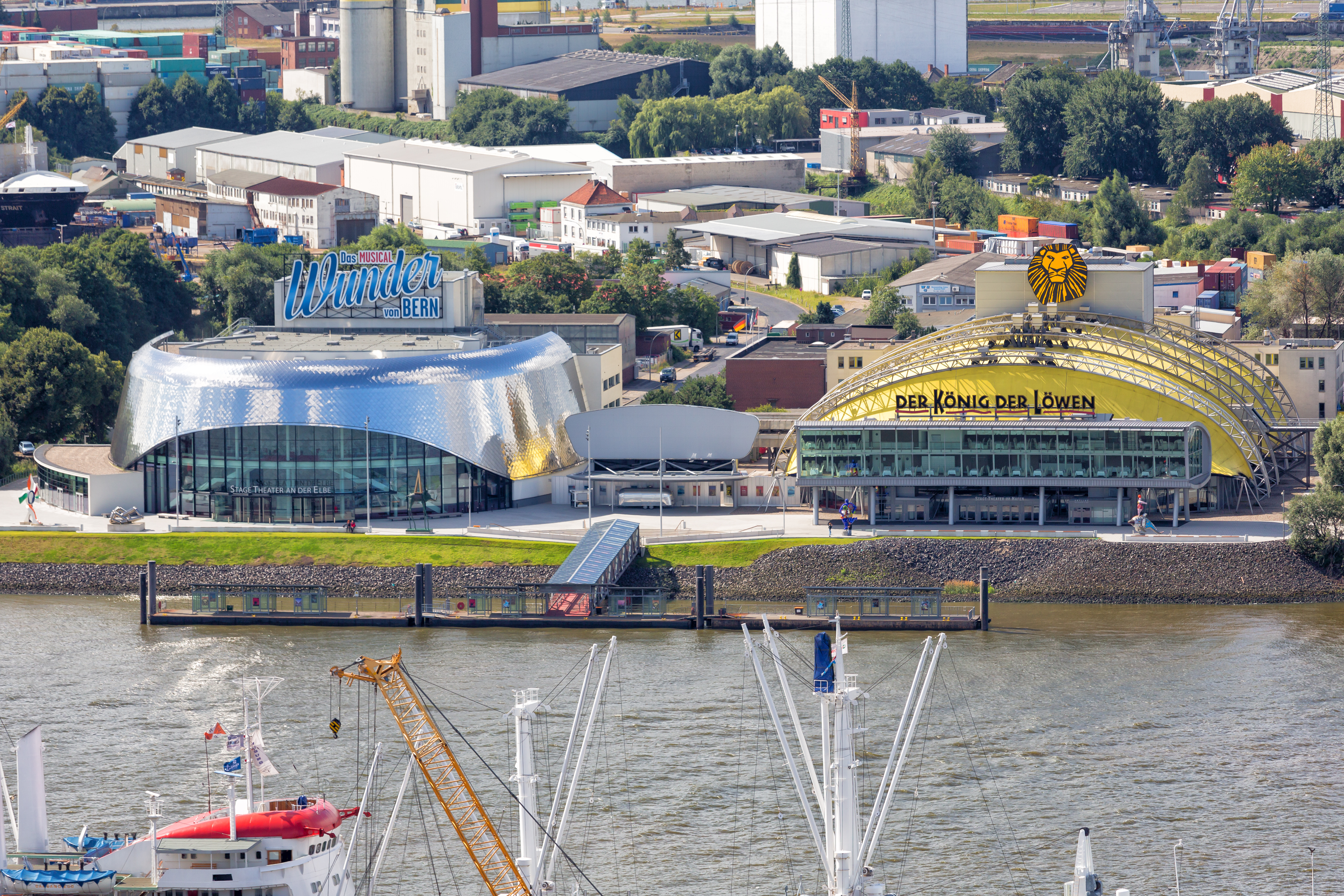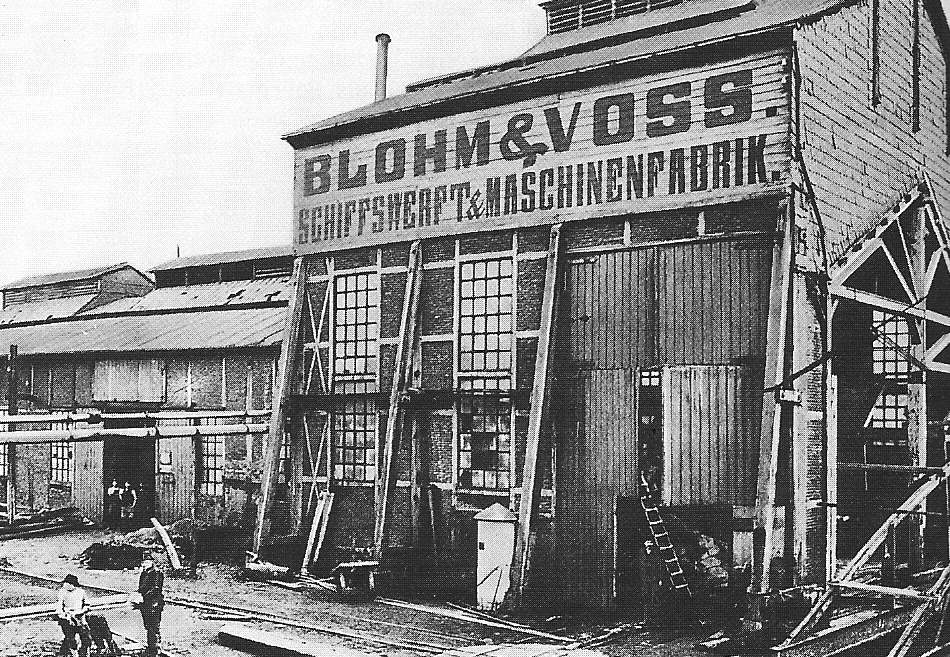Steinwerder on:
[Wikipedia]
[Google]
[Amazon]
Steinwerder (German "stein" stone, "werder" (archaic) island or peninsula, translation "stone peninsula") is a quarter of
 In the north of the district, on the site of the former Stülcken shipyard, the Stage Theater im Hafen (Stage Theatre in the Harbour) was built in 1994. Then in 2013 a second music theatre, the Stage Theater an der Elbe (Stage Theatre on the Elbe) was built next to it.
In the north of the district, on the site of the former Stülcken shipyard, the Stage Theater im Hafen (Stage Theatre in the Harbour) was built in 1994. Then in 2013 a second music theatre, the Stage Theater an der Elbe (Stage Theatre on the Elbe) was built next to it.
 Founded in 1877 by Hermann Blohm and Ernst Voss, Blohm & Voss (B&V) quickly rose to become Hamburg's biggest shipyard. Specialising in steel-hulled ships, these were originally all sailing vessels and only later did the engine business develop. The company built, maintained and repaired ships of all sizes in its shipyards. Most notable was the World War II battleship the Bismarck, at which time B&V was the largest shipyard in Germany.
In 1932 Hermann Blohm's sons founded the
Founded in 1877 by Hermann Blohm and Ernst Voss, Blohm & Voss (B&V) quickly rose to become Hamburg's biggest shipyard. Specialising in steel-hulled ships, these were originally all sailing vessels and only later did the engine business develop. The company built, maintained and repaired ships of all sizes in its shipyards. Most notable was the World War II battleship the Bismarck, at which time B&V was the largest shipyard in Germany.
In 1932 Hermann Blohm's sons founded the Blohm+Voss website
/ref>
(retrieved 21 February 2018)
Hamburg
Hamburg (, ; nds, label=Hamburg German, Low Saxon, Hamborg ), officially the Free and Hanseatic City of Hamburg (german: Freie und Hansestadt Hamburg; nds, label=Low Saxon, Friee un Hansestadt Hamborg),. is the List of cities in Germany by popul ...
, Germany
Germany,, officially the Federal Republic of Germany, is a country in Central Europe. It is the second most populous country in Europe after Russia, and the most populous member state of the European Union. Germany is situated betwee ...
in the borough Hamburg-Mitte
Hamburg-Mitte (Hamburg Central) is one of the seven boroughs of Hamburg, Germany, covering most of the city's urban center. The quarters of Hamburg-Altstadt and Neustadt cover much of the city's historic core. In 2020 the population was 301,231.
...
on the southern bank of the river Elbe
The Elbe (; cs, Labe ; nds, Ilv or ''Elv''; Upper and dsb, Łobjo) is one of the major rivers of Central Europe. It rises in the Giant Mountains of the northern Czech Republic before traversing much of Bohemia (western half of the Czech Re ...
. It is a primarily maritime industrial location, with a resident population in 2017 of only 39.
Local landmarks include two music theatres, the Steinwerder ends of the Old Elbtunnel and Köhlbrand Bridge, and the shipyard of Blohm+Voss Blohm is a surname. Notable people with the surname include:
* Hans Blohm C.M. (born 1927), photographer and author
* Hermann Blohm (1848–1930), German businessman and co-founder of German company Blohm+Voss
* Linn Blohm (born 1992), Swedish hand ...
in which the old Pilot House still stands.
Until 1946, the name was written as Steinwärder. (See also German wikipedia).
It seems to have lent this name to a ship built in 1848 in Altona (on the opposite side of the harbour). This ship was notable for 5 migration voyages from Hamburg to Port Adelaide between 1849 and 1863, after which it was sold and renamed.
Geography
The former island of Steinwerder lies at the confluence of the North Elbe with the Köhlbrand. Together with the neighbouring district of Kleiner Grasbrook, Steinwerder forms the eastern part of the port of Hamburg. The district comprises the port and associated industrial and commercial areas, including shipyards. There is little or no residential housing.hamburg.deEconomy
Steinwerder's economy is dominated by its port and associated maritime industries. Hamburg, including Steinwerder, has taken the relatively unusual step of regenerating and expanding its maritime operations rather than redeveloping the waterfront for other uses.Transport
The Old Elbe Tunnel has linked Steinwerder to St. Pauli on the northern river bank since 1911 and is open to both road vehicles and pedestrians. TheKöhlbrand Bridge
The Köhlbrand Bridge (german: Köhlbrandbrücke) is a cable-stayed bridge in Hamburg, Germany,Stahl, F. L., & Gagnon, C. P. (1996)Cable Corrosion in Bridges and Other Structures: Causes and SolutionsASCE Publications. . Retrieved on 16 March 20 ...
connects Steinwerder with Waltershof to the west, linking the two halves of the port. It is the second longest bridge in Germany, being opened in 1974.
Landmarks
Pilot house
In 1902 a brick house with a round tower was built for the Hamburg harbour pilots. When the pilots moved elsewhere, in 1925 Blohm & Voss took it over. It is nowadays surrounded by dockyards and is only visible from the river Elbe.Twin music theatres
 In the north of the district, on the site of the former Stülcken shipyard, the Stage Theater im Hafen (Stage Theatre in the Harbour) was built in 1994. Then in 2013 a second music theatre, the Stage Theater an der Elbe (Stage Theatre on the Elbe) was built next to it.
In the north of the district, on the site of the former Stülcken shipyard, the Stage Theater im Hafen (Stage Theatre in the Harbour) was built in 1994. Then in 2013 a second music theatre, the Stage Theater an der Elbe (Stage Theatre on the Elbe) was built next to it.
History
Steinwerder was once called Nordersand (North Sands) and was an island until the dike-building of the Middle Ages brought it into use as farmland. After the Great Fire of 1842 so much rubble was dumped on the island that it was raised significantly above river level. This led to the change of name to "Stone island". In the mid-19th century the first shipyards appeared in the district. A decisive turning point came in 1877 with the founding of the shipyardBlohm & Voss
Blohm+Voss (B+V), also written historically as Blohm & Voss, Blohm und Voß etc., is a German shipbuilding and engineering company. Founded in Hamburg in 1877 to specialise in steel-hulled ships, its most famous product was the World War II battl ...
. More followed. At the turn of the century, the harbour was further expanded.
In 1894 Steinwerder was incorporated as a district and in 1902 officially adopted its current name.
Steinwerder was badly damaged during the bombing of Hamburg
The Allied bombing of Hamburg during World War II included numerous attacks on civilians and civic infrastructure. As a large city and industrial centre, Hamburg's shipyards, U-boat pens, and the Hamburg-Harburg area oil refineries were attack ...
in World War II. After the Second World War, the British continued to demolish the shipyards of Steinwerder. Many of the large shipyards, including Stülcken and Schlieker, have disappeared and B&V is smaller than it used to be.
Blohm & Voss
 Founded in 1877 by Hermann Blohm and Ernst Voss, Blohm & Voss (B&V) quickly rose to become Hamburg's biggest shipyard. Specialising in steel-hulled ships, these were originally all sailing vessels and only later did the engine business develop. The company built, maintained and repaired ships of all sizes in its shipyards. Most notable was the World War II battleship the Bismarck, at which time B&V was the largest shipyard in Germany.
In 1932 Hermann Blohm's sons founded the
Founded in 1877 by Hermann Blohm and Ernst Voss, Blohm & Voss (B&V) quickly rose to become Hamburg's biggest shipyard. Specialising in steel-hulled ships, these were originally all sailing vessels and only later did the engine business develop. The company built, maintained and repaired ships of all sizes in its shipyards. Most notable was the World War II battleship the Bismarck, at which time B&V was the largest shipyard in Germany.
In 1932 Hermann Blohm's sons founded the Hamburger Flugzeugbau
''Hamburger Flugzeugbau'' (HFB) was an aircraft manufacturer, located primarily in the Finkenwerder quarter of Hamburg, Germany. Established in 1933 as an offshoot of Blohm & Voss shipbuilders, it later became an operating division within its par ...
(HFB) to make all-metal aeroplanes in the shipyards, which were suffering from the global depression. For several years the HFB offices occupied the top floor of the B&V main headquarters in Steinwerder and the aircraft were manufactured at the Steinwerder works. When shipbuilding picked up again in the late 1930s the aircraft work was moved elsewhere. At around the same time, the aircraft business was reorganised as a subsidiary of Blohm & Voss.
During the war the B&V site became a subcamp of Neuengamme concentration camp
Neuengamme was a network of Nazi concentration camps in Northern Germany that consisted of the main camp, Neuengamme, and more than 85 satellite camps. Established in 1938 near the village of Neuengamme in the Bergedorf district of Hamburg, th ...
.
B&V's fortunes revived in 1952 when the City of Hamburg guaranteed credit to the B&V subsidiary Steinwerder Industrie AG, formed in 1950, to restart ship repairs and by 1953 some 900 workers were back in employment.Henry Burke Wend; ''Recovery and Restoration: U.S. Foreign Policy and the Politics of Reconstruction of West Germany's Shipbuilding Industry'', Praeger, 2001, pp.196–198.
B&V diversified into private yachts and offshore oil installations. The Eclipse built for the Russian billionaire Roman Abramovich
Roman Arkadyevich Abramovich (, ; he, רומן ארקדיביץ' אברמוביץ'; born 24 October 1966) is a Russian oligarch and politician. He is the former owner of Chelsea, a Premier League football club in London, England, and is the ...
is, at in length, the second-longest private yacht in the world.
B&V is no longer in private ownership. Today it is a subsidiary of Lürssen
Lürssen (or Lürssen Werft) is a German shipyard with headquarters in Bremen-Vegesack and shipbuilding facilities in Lemwerder, Berne and Bremen-Fähr-Lobbendorf.
Lürssen designs and constructs yachts, naval ships and special vessels. Tradi ...
and styles its name "Blohm+Voss"./ref>
See also
* List of subcamps of NeuengammeSources
Notes
Bibliography
*Hans Amtmann
Hans H. Amtmann (1906–2007) was a German aircraft designer.
He is best known for his work at Blohm & Voss, where he worked as Head of New Projects under Chief Designer Richard Vogt during the World War II era. After the war, he moved the United ...
; ''The Vanishing Paperclips'', Monogram, 1988.
* Hermann Pohlmann
Hermann Pohlmann (26 June 1894 – 7 July 1991) was a German aerospace engineer.
He was the principal designer of the Junkers Ju 87 ''Stuka'', a dive bomber used during World War II, before becoming Deputy Chief Designer at Blohm & Voss.
Aft ...
; ''Chronik Eines Flugzeugwerkes 1932-1945'', Motorbuch, 2nd Impression, 1982. (In German).
* "Steinwerder: Information and sights", hamburg.de (In German(retrieved 21 February 2018)
External links
{{Authority control Quarters of Hamburg Hamburg-Mitte